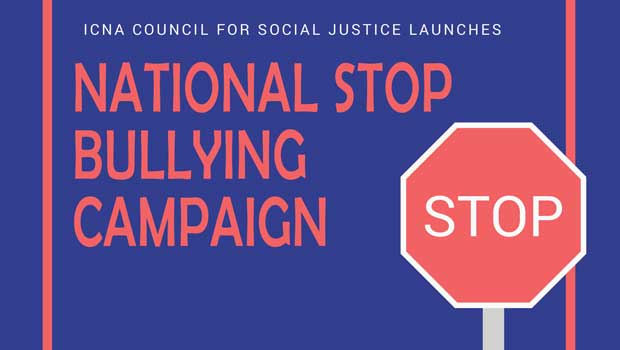ICNA Council for Social Justice Launches National Anti-Bullying Campaign
Three years ago, Nadia and her older sister made the joint decision, independent of their parents’ input, to wear hijab (head and body covering for Muslim females for the sake of modesty) to their public elementary school. Their mother dresses in full hijab every day that she steps outside of her family’s front door and her daughters have benefited from the example of a strong hijabi mother. Before making the decision to wear hijab to school, Nadia was a popular but quiet girl who was very rarely the target of bullies in her school. All of that changed when the two sisters showed up one day with scarves on their heads and legs and arms covered by loosely-fitting garments. At first, the taunting and bullying was more playful than mean-spirited, but as the weeks and months went by, it became obvious that some of their schoolmates were directing hurtful comments towards them that were echoed from television, older youth, parents, teachers, and even school administrators.
School bullying in America is as old as one-room school houses with a single teacher for first through the twelfth grades. During the approximately 100-year post-slavery era of racially-segregated public schools, racial homogeneity did not spare children from being ridiculed and picked on by their class and schoolmates. Yet, as the ethnic, racial, and religious composition of schools became more diverse, school bullying increased exponentially. Racial and ethnic epithets werenow hurled at children by their peers and adults. In school districts where racial and religious bigotry dominate the landscape, many children are mercilessly mocked and derided with impunity.Because of the seemingly cavalier attitude taken by far too many teachers and school administrators nationwide, when incidents of bullying are reported to them and they do nothing to stop it, children are being emotionally scarred, some permanently.
Children from minority populations in this country, such as Jews, Latinos, African Americans, Muslims, Sikhs, and Asians, are routinely on the receiving end of barbed threats, insults, physical intimidation and attacks. As the political climate in America becomes more toxic, even very young children are not spared from verbal and physical torment on a day-to-day basis.Sadly, bullying has become normative behavior against anyone considered different from the majority population group. As a direct result of school and cyberbullying, children, ages 10-14, currently have the highest rate of suicide in the country. Education, social activist, and religious-based groups are taking a nationwide stance to inform and mobilize the American people against bullying and the deleterious effect that this behavior is having on our precious children and the country at large. The Islamic Circle of North America, through its civic engagement division, ICNA Council for Social Justice, is taking a stand against school bullying by waging a year-long national campaign, “Protecting Our Children: Stop School Bullying.”
The national campaign will be spearheaded by the ICNA Council for Social Justice in conjunction with local units and subunits of ICNA. The organization will utilize its multi-platform social media outlets, billboards, and the mass media to promote the campaign. This national awareness campaign is designed to mobilize diverse demographic populations to take individual and collective actions in their school districts to reduce, if not eliminate, the unacceptable practice of school bullying. Parents, teachers, teacher unions, school administrators and superintendents, and students, themselves, are the target audience of this initiative. Most of the children bullied in school do not report to their parents or school authorities that they have been victimized, primarily for fear of reprisals against them. ICNA Council for Social Justice has established a Justice Hotline, 1 (844) 99-JUSTICE, for individuals to call and report incidents of bullying or other social injustices. In addition, ICNA CSJ will facilitate sensitivity sessions for teachers and school administrators to make them aware of this serious problem and to push them to take appropriate action when incidents of bullying are reported. As part of the national campaign, mayors and city councils will be called upon to establish “Stop Bullying Our Children” days in their areas. School principals will be called upon to hold special assemblies to address bullying in schools and online. Faith community leaders will also be enlisted to help stem this worrisome tide. For additional information, please contact Rameez Abid through the Justice Hotline: (844) 99-Justice; or email scribe51@gmail.com
——————————————–
Effects of Bullying
• Students who experience bullying are at increased risk for poor school adjustment, sleep difficulties, anxiety, and depression (Center for Disease Control, 2015).
• Students who engage in bullying behavior are at increased risk for academic problems, substance use, and violent behavior later in adolescence and adulthood (Center for Disease Control, 2015).
• Students who are both targets of bullying and engage in bullying behavior are at greater risk for both mental health and behavior problems than students who only bully or are only bullied (Center for Disease Control, 2015).
• Students who experience bullying are twice as likely as non-bullied peers to experience negative health effects such as headaches and stomachaches (Gini & Pozzoli, 2013).
• Youth who self-blame and conclude they deserved to be bullied are more likely to face negative outcomes, such as depression, prolonged victimization, and maladjustment (Perren, Ettakal, & Ladd, 2013; Shelley & Craig, 2010).
Source: http://www.pacer.org/bullying/resources/stats.asp
Bullying and Suicide
The relationship between bullying and suicide is complex. Many media reports oversimplify this relationship, insinuating or directly stating that bullying can cause suicide. The facts tell a different story. In particular, it is not accurate and potentially dangerous to present bullying as the “cause” or “reason” for a suicide, or to suggest that suicide is a natural response to bullying. We recommend media not use the word “bully-cide.”
• Research indicates that persistent bullying can lead to or worsen feelings of isolation, rejection, exclusion, and despair, as well as depression and anxiety, which can contribute to suicidal behavior.
• The vast majority of young people who are bullied do not become suicidal.
• Most young people who die by suicide have multiple risk factors.
• Some youth, such as LGBT youth, are at increased risk for suicide attempts even when bullying is not a factor.
Source: https://www.stopbullying.gov/media/facts/index. html#suicide




